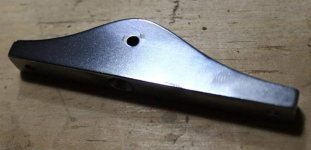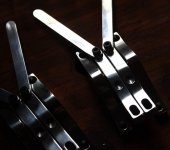shadpeters
Plastic
- Joined
- Aug 24, 2021
Hey guys, so quick intro, my name is Shad Peters, I don't have a metal working background. I'm mainly a luthier and woodworker, but my instrument making occasionally leads me into some metal working pursuits. One such pursuit has recently had me machining some of my own hardware from aluminum, and I'm just learning as I go.
I have read through several threads on here that have been very useful both in helping me better understand the tumbling process, and in pointing me towards products and other resources, but I haven't seen this exact issue broached, that is, a peened/pitted surface.
I'm currently using the 2.5 gallon drum from C&M topline and start with plastic pyramids. I get a really nice surface this way, but have yet to nail down a hands off approach to polishing. I'm using the same tl-4 barrel with crushed walnut shells. I've added McGuire's polishing compound to the media which seems to be working, but since the media is so light weight compared to the plastic, the parts are smashing into each other and damaging the surface. After 12 hours of tumbling the parts start to brighten up but the surface also starts to look slightly pitted/peened which has left me doing a lot more hand work on the buffer than I'd like.
Any suggestions on how I might solve this problem? I have wondered if maybe I need to fill the drum with more media? or if maybe a vibratory tumbler would be gentler on the parts? or maybe I need a whole different media. Any advice would be welcome. thanks.
Other possibly useful information: The parts are small, all of them are machined from 3/8" aluminum plate. They range in length from 2-3.25 inches, and in width from 1/2"-3/4". I'm typically running 40-80 parts at once. My barrel is about 50% full with the parts and media in it. Maybe slightly over 50%.
Thanks for your help!
Shad.
I have read through several threads on here that have been very useful both in helping me better understand the tumbling process, and in pointing me towards products and other resources, but I haven't seen this exact issue broached, that is, a peened/pitted surface.
I'm currently using the 2.5 gallon drum from C&M topline and start with plastic pyramids. I get a really nice surface this way, but have yet to nail down a hands off approach to polishing. I'm using the same tl-4 barrel with crushed walnut shells. I've added McGuire's polishing compound to the media which seems to be working, but since the media is so light weight compared to the plastic, the parts are smashing into each other and damaging the surface. After 12 hours of tumbling the parts start to brighten up but the surface also starts to look slightly pitted/peened which has left me doing a lot more hand work on the buffer than I'd like.
Any suggestions on how I might solve this problem? I have wondered if maybe I need to fill the drum with more media? or if maybe a vibratory tumbler would be gentler on the parts? or maybe I need a whole different media. Any advice would be welcome. thanks.
Other possibly useful information: The parts are small, all of them are machined from 3/8" aluminum plate. They range in length from 2-3.25 inches, and in width from 1/2"-3/4". I'm typically running 40-80 parts at once. My barrel is about 50% full with the parts and media in it. Maybe slightly over 50%.
Thanks for your help!
Shad.






